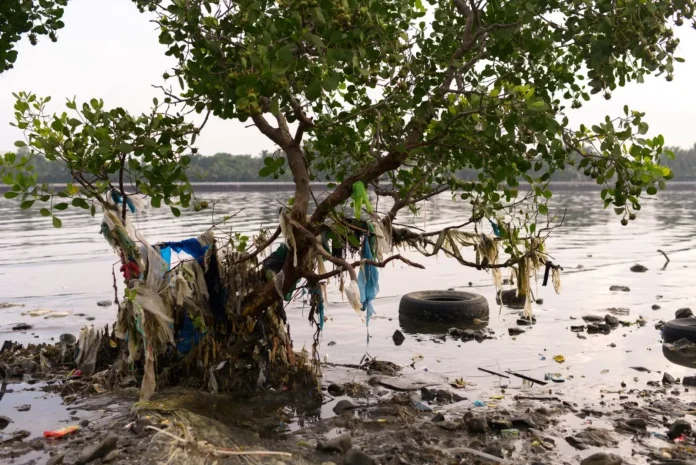Along the flood-prone coasts of the Philippines, one of the defining dilemmas of the climate crisis – how to balance environmental needs with economic development – is dominating a debate around the restoration of mangrove forests.
Conservationists want the government to ensure disused aquaculture ponds – used to farm fish and shellfish – revert to their natural state as mangrove forests, allowing them to form a natural barrier against erosion, floods, and storm surges.
But they fear a new law to boost the struggling salt industry – the Philippine Salt Industry Development Act – could see these fishponds converted to salt farms instead, creating less favorable conditions for restoration.
Mangroves are crucial in the fight against climate change because they are more effective than most other forests at absorbing and storing planet-heating carbon.
As well as acting as a natural barrier to coastal erosion and storms, they also support a range of wildlife and provide nutrients to the wider ecosystem, boosting fish stocks.
That’s why conservationists have long called on the Philippine government and the Bureau of Fisheries and Aquatic Resources (BFAR), which oversees the process, to speed up the reversion of fishponds to mangroves.
But the government has yet to come up with a concrete response, conservationists say, and the new salt act, which is meant to revive the salt industry, including by potentially using the disused fishponds as salt farms, is complicating the issue.
Members of the National Academy of Science and Technology (NAST), the Philippines’ highest scientific advisory body, warned the government in January that the bill might allow “unlimited areas of abandoned fishponds and other coastal habitats” to be converted to salt farms, and affect mangroves’ critical ecology.
After President Ferdinand Marcos Jr signed the bill into law in March, Wetlands International Philippines called for regulations to “ensure it balances salt production, aquaculture, and environmental sustainability”.
“The signing of the national salt industry bill raises valid concerns about its potential environmental impact, particularly regarding the increased salinity levels in AUU (abandoned, undeveloped and underutilized) fishponds soils,” Annadel Cabanban, country director for Wetlands International Philippines said in a statement.
“Increased salinity in the soils will make it difficult to revert AUU fishponds to mangrove forests,” Cabanban said.
Conservation groups, including Wetlands International, have met with officials from BFAR to discuss the expansion of the salt-pan industry and clarify if degraded fishponds will be used. BFAR did not respond to a request for comment.
Dubious landowners and data gaps
The rapid expansion of aquaculture in the Philippines from the 1960s to the mid-1970s saw the conversion of mangrove swamps into brackish fishponds as the government promoted aquaculture production for food security.
It’s a common tale in the region. Around a third of the total 18 million hectares (44 million acres)of global mangrove forests can be found in Southeast Asia, but aquaculture was the biggest driver of mangrove loss here over the last 20 years.
But now, conservationists from Indonesia to Malaysia are working to restore mangrove forests in a region regularly slammed by typhoons and tsunamis.
More than half of the Philippines’ 450,000 hectares of mangrove forests were lost to fishponds and other coastal development projects but only around 900 hectares have reverted to mangrove forests.

The reasons are complex and include political and tenure issues, poor monitoring and recording of lease agreements, and conflicting government policies, said Cabanban.
She said one of the biggest challenges was to identify the fishponds that are ready to return to their original state.
“Some landowners may be reluctant to give up their fishponds, even if they are no longer productive, due to the potential future value of the land or the perceived loss of income and property rights,” she said.
Neither is the restoration process straightforward. It is not enough to simply replant the forests as this could focus on the wrong species or wrong areas, causing projects to fail.
Instead, conservationists recommend mapping the best areas for growth and concentrating on those. But this work is complicated by the absence of a comprehensive inventory and assessment of degraded fishponds, said Jocel Pangilinan from Wetlands International Philippines.
“Because of these data gaps, we really don’t know the entire universe of this mangrove restoration effort here,” she said.
Cabanban said mangrove forests can also provide economic benefits for local communities as they provide nursery sites for young fish – including shellfish, crabs, and shrimps – and can boost livelihoods in the fisheries sector.
Jurgenne Primavera, a marine scientist at the Zoological Society of London and a member of NAST, said both the environment and people could benefit from restoration.
“It’s a false dichotomy that we either revert abandoned fishponds to mangroves or maintain food security [with aquaculture] because mangroves are also essential for social equity and food security for municipal fishers,” she said.
($1 = 55.3250 Philippine pesos)









